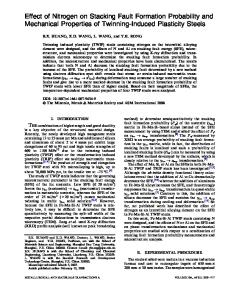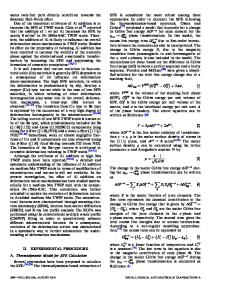Mechanical milling-induced deformation twinning in Fcc materials with high stacking fault energy
- PDF / 1,422,286 Bytes
- 6 Pages / 612 x 792 pts (letter) Page_size
- 15 Downloads / 439 Views
Mechanical Milling–Induced Deformation Twinning in Fcc Materials with High Stacking Fault Energy JIANHONG HE, KYUNG H. CHUNG, XIAOZHOU LIAO, YUNTAIN T. ZHU, and ENRIQUE J. LAVERNIA Various mechanical milling/alloying techniques have been widely used to produce nanocrystalline and other nonequilibrium structures, sometimes in large quantities. Approximately 4000 research papers investigating the processing, properties, microstructures, and applications of the milled materials have been published to date.[1] In these studies, it is frequently stated that various crystal defects such as dislocations, vacancies, stacking faults, and increased grain boundaries are generated due to heavy deformation caused by mechanical milling. However, only limited individual observations of crystal defects in the milled materials have been reported; two notable exceptions are the evolution of dislocation structure in milled Ru and Al-Ru, which was examined in detail by high-resolution transmission electron microscopy (HRTEM)[2] and the HRTEM observation of deformation twins in the milled Cu.[3] Deformation twins[4]
or annealing twins[5] were believed to contribute to the strengthening of materials. On the basis of the apparent grain-refinement effect of twinning with twin boundaries acting as obstacles to dislocations,[4,5,6] several modified Hall–Petch equations have been established to exhibit the influence of twins on the strength and work-hardening rate of materials.[4,5] Detailed studies[7,8,9] on the microstructure and mechanical performance of nanocrystalline Cu and Pd, synthesized by inert gas condensation followed by hot pressing at 1.4 GPa pressures, have been performed. The HRTEM and X-ray diffraction (XRD) studies, as well as conventional transmission electron microscopy (TEM) observations, indicated the presence of a large number of highly twinned grains, whose origin is possibly related to the inert gas condensation process[7] or formed by shear stresses during sintering of the nanocrystalline powder.[8] The twinned structure was thought to be responsible for the higher creep resistance in the nanocrystalline Cu and Pd, because twin boundaries are poor paths for vacancy diffusion and resist grain boundary sliding.[9] In this article, the presence of deformations twins in several milled fcc metals and alloys with high stacking fault energy (100 to 200 ergs/cm2) was observed using conventional TEM and HRTEM, and the density of twins was analyzed using XRD. Commercially available metal and alloy powders were mechanically cryomilled in a modified Union Process 01-ST (Union Process, Inc., Akron, OH) attritor with a grinding tank capacity of 0.0057 m3 at a rate of 180 rpm in a stainless tank containing stainless steel balls. The ball-to-powder mass ratio used was 20:1 (500 g powder was loaded for each milling). Liquid nitrogen was continuously introduced into the tank during the milling. The flux of liquid nitrogen was properly controlled using a valve so that the milling temperature, monitored by a thermocouple, was maintain
Data Loading...











